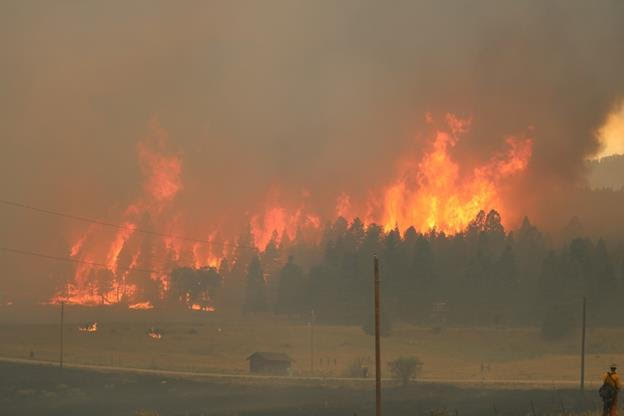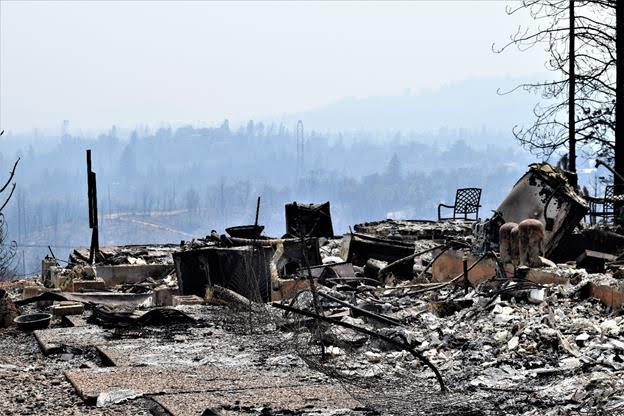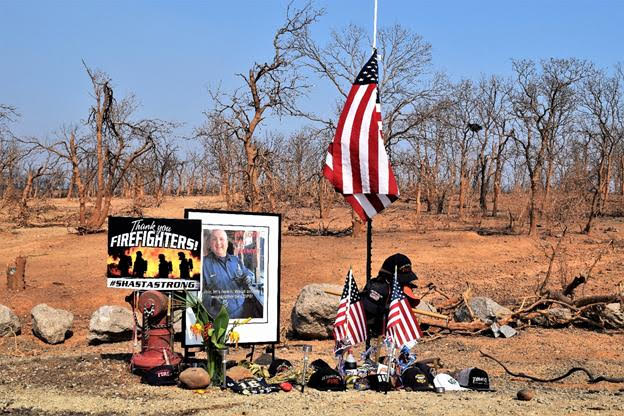
North Spring fire, Colorado - courtesy of Mark Grewe
Brought to you by WBIW News and Network Indiana
Last updated on Tuesday, September 11, 2018
(BEDFORD) - Since January 1, there have been over 46,000 wildfires, which have burned over 7 million acres. August is the peak month for fire activity across the western United States, and many of the Hoosier National Forest staff participated in the efforts to contain western fires last month. In addition to those on the front lines actively doing fire suppression, many staff members are needed behind the scenes to provide the necessary support.

North Spring fire, Colorado - courtesy of Mark Grewe
That support may take the form of managing a base camp, radio operation, or providing information to media and the public, just to name a few roles. Assignments are generally 14 days, with no days off during that time. Work schedules include long days and can be quite stressful, as employees are challenged with new duties in unfamiliar areas, working with constantly changing staff.
Katie Slezak, a plant biological technician with the Tell City Ranger District, worked as a radio operator at the Cougar Creek fire, outside Wenatchee, Washington. As a radio operator, she worked in the communications unit and responded to radio traffic from the fire line and also within the camp. She received line orders and supply orders and had to ensure that the messages were given to the right people.
She also helped with medical incidents by relaying information from the medical unit leader to the staff at the incident. These were often the most challenging situations. According to Slezak, "It is difficult multi-tasking in medical incidents. You have 50 people trying to help and give direction, but as a radio operator you just need to stay focused, calm, and collected and only relay what is necessary."
Despite the challenges, there are rewards. Slezak says, "I started the assignment as a trainee but was qualified (ie. met the training requirements) while I was there. I enjoyed being able to help people via radio during medical incidents. We were often complimented on how good our communication was, and that was greatly due to my team and I were able to stay calm and concise on the radio."
Andrea Crain is a seasoned fire support person, having worked on the Shasta-Trinity National Forest in northern California for many years. Now the public affairs officer at the Hoosier National Forest, Crain was called back to her former duty station shortly after the Carr Fire broke out. She spent the latter half of August as a public information officer for both that fire and the Hirz Fire, also on the Shasta-Trinity. Her duties included media relations, public, and media phone lines, radio and television interviews, social media, and coordinating with local, state, and federal government offices. She also ensured that the U.S. Forest Service Incident Management Team stayed on message and followed agency policy.
Due to the nature of these fires encompassing private land, as well as several federal land management agencies, a joint incident command system was set up between the U.S. Forest Service, National Park Service, and CAL FIRE. This added a level of complexity in communications due to different agency priorities and procedures.

Carr Fire, burned home, photo courtesy of Eric Coulter, Bureau of Land Management
The Carr fire destroyed 1079 homes and 229,651 acres, much of it beloved public land, as well as had eight fatalities. Crain said she found emotional conversations with people looking for information and seeing so much devastation in the place she calls her second hometown the most difficult to deal with.
Despite the intense personal emotional reactions working this fire brought, Crain indicated it was worth it. "I really enjoy being able to help, to be a bridge between firefighters and the public. It's very rewarding to help a public person who has no idea where to go for answers about their property or loved ones. I also get to be the person who helps the public show their appreciation to the firefighters. Children write cards, grandmothers send cookies, organizations create large public displays. Public information officers often get to coordinate or deliver these gestures."
Jason Barnes can usually be found in his cubicle in Bedford, crunching numbers as a budget analyst for the Hoosier National Forest. However, this summer he was assigned to the North Spring fire in Walsenburg, Colorado as one of three base camp managers. Basecamp managers are one of the first people to arrive at a camp location and are usually the last to leave.

Katie Slezak, radio operator
According to Barnes, "We maintain the camp and ensure everything is kept running, and position all areas of the camp. It was my job to support, and make comfortable, all firefighters and staff during their stay. This includes establishing sleeping arrangements and locations for all personnel, ensuring adequate restroom and hygiene facilities are available to all staff, and establishing parking locations for all vehicles and heavy equipment that need a place to stage or park. I also had to ensure all grounds and facilities used were maintained for the condition received, and to try and leave it better than we found it."
Luckily, there was 40 camp crew staff to assist in carrying out these duties for the up to 1300 staff that were stationed there.
An essential part of the assignment was to establish points of contact and relationships within the local communities to ensure that they could create contingencies for additional overhead locations if needed due to camp size growth. It could be challenging to find local vendors to be able to provide some equipment and supplies needed due to the large scale of the operation and other numerous fires within the region.
Barnes found his reward in seeing the firefighters resting comfortably, knowing that they had everything they needed to accomplish their mission and to stay fresh and clear minded.
Why do Hoosier National Forest staff take on these additional challenges? Perhaps Katie Slezak summed it up best, "I really just got to meet a lot of great people and made some lifelong connections, that is one of my favorite things about the fire community...I have no doubt that I will see these people again."

Carr Fire, firefighter gratitude, photo courtesy of Eric Coulter, Bureau of Land Management
Wildland fire can be a friend and a foe. In the right place at the right time, wildland fire can create many environmental benefits, such as reducing grass, brush, and trees that can fuel large and severe wildfires and improving wildlife habitat. In the wrong place at the wrong time, wildfires can wreak havoc, threatening lives, homes, communities, and natural and cultural resources.
The U.S. Forest Service has been managing wildland fire on national forests and grasslands for more than 100 years. But the Forest Service doesn't - and can't - do it alone. To be successful, the agency works closely with other federal, tribal, state, and local partners, and relies on staff from across the country with a variety of skills.
1340 AM WBIW welcomes comments and suggestions by calling 812.277.1340 during normal business hours or by email at comments@wbiw.com
© Ad-Venture Media, Inc. All Rights Reserved.